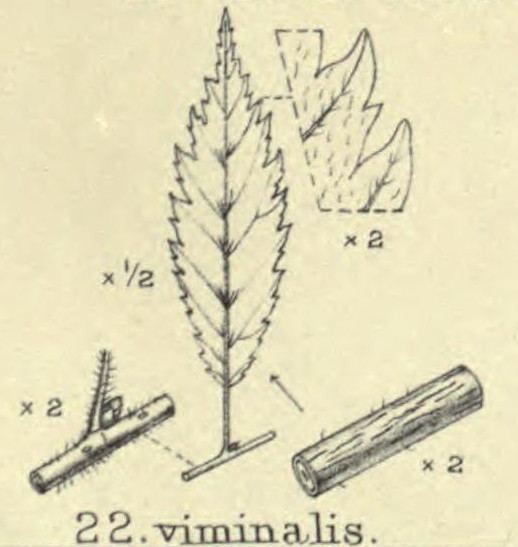Origin England Rank Cultivar | Higher classification Ulmus minor 'Plotii' | |
 | ||
Hybrid parentage U. minor × U. minor 'Plotii' | ||
Ulmus 'Viminalis' is a hybrid elm cultivar derived from the crossing U. minor × U. minor 'Plotii'. An U. campestris viminalis was raised and listed by Masters in 1831, without description. Though Loudon added a general description in 1838, Elwes and Henry described and illustrated in detail in 1913 a form they appear to treat as the 'type'. Melville considered 'Viminalis' one form of the natural, variable hybrid U. × viminalis, while Boom (1959) and Bean listed 'Viminalis' as a cultivar and the 'type' clone of U. × viminalis.
Contents
Description
Both Loudon's and Elwes and Henry's leaf-drawings show a narrow, acuminate, deeply serrated, almost symmetrical leaf, tapering to a wedge-shaped base. Loudon's sketch (below) suggests that this leaf-form was fairly uniform on his tree. 'Viminalis' would appear to be the form of U. × viminalis that has been likened to Zelkova × verschaffeltii, as distinct from the birch-leaved form 'Betulaefolia' and a putative form with "irregular" leaves, 'Incisa'. Henry's "tree with ascending branches, pendulous branchlets, and sparse foliage" presumably covers the profile of his 'type' tree.
Pests and diseases
Trees of the U. × viminalis group are very susceptible to Dutch elm disease.
Cultivation
Cultivars of the U. × viminalis group were planted in Great Britain and Ireland and have been introduced to continental Europe, North America and Australasia, where a few specimens survive in arboreta. Specimens supplied by the Späth nursery to the Royal Botanic Garden Edinburgh in 1902 as U. campestris viminalis may survive in Edinburgh as it was the practice of the Garden to distribute trees about the city (viz. the Wentworth Elm); the current list of Living Accessions held in the Garden per se does not list the plant.
Notable trees
Elwes and Henry list notable specimens "of this variety" (the tree described and illustrated) in the Cambridge University Botanic Garden (70 ft) and in Gisselfelde, Denmark (60 ft).
